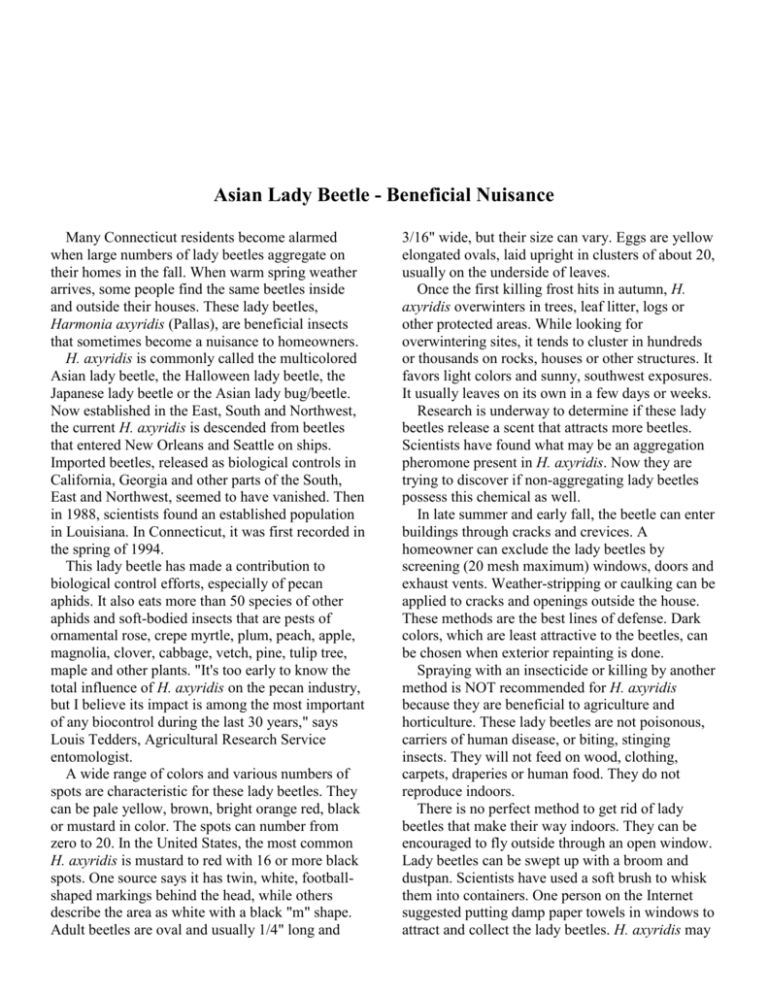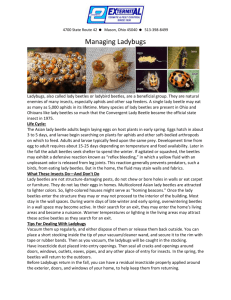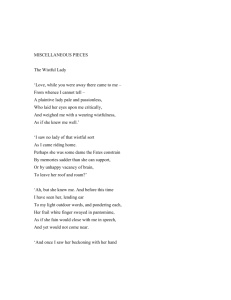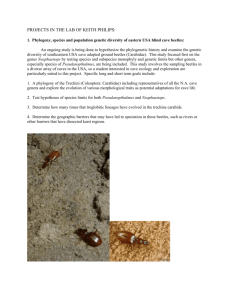Asian Lady Beetle - Home & Garden Education Center
advertisement

Asian Lady Beetle - Beneficial Nuisance Many Connecticut residents become alarmed when large numbers of lady beetles aggregate on their homes in the fall. When warm spring weather arrives, some people find the same beetles inside and outside their houses. These lady beetles, Harmonia axyridis (Pallas), are beneficial insects that sometimes become a nuisance to homeowners. H. axyridis is commonly called the multicolored Asian lady beetle, the Halloween lady beetle, the Japanese lady beetle or the Asian lady bug/beetle. Now established in the East, South and Northwest, the current H. axyridis is descended from beetles that entered New Orleans and Seattle on ships. Imported beetles, released as biological controls in California, Georgia and other parts of the South, East and Northwest, seemed to have vanished. Then in 1988, scientists found an established population in Louisiana. In Connecticut, it was first recorded in the spring of 1994. This lady beetle has made a contribution to biological control efforts, especially of pecan aphids. It also eats more than 50 species of other aphids and soft-bodied insects that are pests of ornamental rose, crepe myrtle, plum, peach, apple, magnolia, clover, cabbage, vetch, pine, tulip tree, maple and other plants. "It's too early to know the total influence of H. axyridis on the pecan industry, but I believe its impact is among the most important of any biocontrol during the last 30 years," says Louis Tedders, Agricultural Research Service entomologist. A wide range of colors and various numbers of spots are characteristic for these lady beetles. They can be pale yellow, brown, bright orange red, black or mustard in color. The spots can number from zero to 20. In the United States, the most common H. axyridis is mustard to red with 16 or more black spots. One source says it has twin, white, footballshaped markings behind the head, while others describe the area as white with a black "m" shape. Adult beetles are oval and usually 1/4" long and 3/16" wide, but their size can vary. Eggs are yellow elongated ovals, laid upright in clusters of about 20, usually on the underside of leaves. Once the first killing frost hits in autumn, H. axyridis overwinters in trees, leaf litter, logs or other protected areas. While looking for overwintering sites, it tends to cluster in hundreds or thousands on rocks, houses or other structures. It favors light colors and sunny, southwest exposures. It usually leaves on its own in a few days or weeks. Research is underway to determine if these lady beetles release a scent that attracts more beetles. Scientists have found what may be an aggregation pheromone present in H. axyridis. Now they are trying to discover if non-aggregating lady beetles possess this chemical as well. In late summer and early fall, the beetle can enter buildings through cracks and crevices. A homeowner can exclude the lady beetles by screening (20 mesh maximum) windows, doors and exhaust vents. Weather-stripping or caulking can be applied to cracks and openings outside the house. These methods are the best lines of defense. Dark colors, which are least attractive to the beetles, can be chosen when exterior repainting is done. Spraying with an insecticide or killing by another method is NOT recommended for H. axyridis because they are beneficial to agriculture and horticulture. These lady beetles are not poisonous, carriers of human disease, or biting, stinging insects. They will not feed on wood, clothing, carpets, draperies or human food. They do not reproduce indoors. There is no perfect method to get rid of lady beetles that make their way indoors. They can be encouraged to fly outside through an open window. Lady beetles can be swept up with a broom and dustpan. Scientists have used a soft brush to whisk them into containers. One person on the Internet suggested putting damp paper towels in windows to attract and collect the lady beetles. H. axyridis may be released outside in warmer weather, away from homes, near a source of food or in a greenhouse. Aforementioned entomologist Louis Tedders stores lady beetles, captured during the winter, in containers in a refrigerator. He brings them out once a week to warm up and sip sugar water. In the spring, when aphids are available outdoors, he releases the beetles. Some sources say that a vacuum cleaner crevice tool can be used to get rid of H. axyridis. This method sometimes kills the lady beetles. The dead beetles, if allowed to accumulate in the vacuum cleaner bag for several days, may cause an odor. If the beetles remain alive, they may escape from the cleaner into the house. In either case, the homeowner is advised to seal the bag tightly and dispose of it as soon as the vacuuming is complete. A piece of cloth may be put over the nozzle to collect the lady beetles alive; then they may be released as advised above. Handled lady beetles exhibit a stress-related defensive behavior by secreting a harmless, orange substance out the joints of the legs. This substance is actually lady bug blood, says Tedders. If you trap one in your hand for several seconds, you may see a spot of beetle blood on your palm. This blood can stain walls and fabric. Populations are expected to remain high indefinitely. The lady beetles do have a few natural enemies. North Carolina research has shown the lady beetle to be parasitized by a tachinid fly. A wasp in the Braconid family is another enemy of H. axyridis. Home gardeners are encouraged to put up with this nuisance in their homes, because they may find H. axyridis eating harmful aphids on their garden plants in the summer. Patsy W. Evans, Research Assistant, University of Connecticut, Storrs, CT Reviewed by UConn Home & Garden Education Center 2005 References: Day, W. H. Personal communication. DeQuattro, J. Gotcha, Agricultural Research,March 1995 pp.5-8. Hamilton, G. Don't be Spooked by the Halloween Ladybug.News release. September 29, 1995. Lyon, W. F. Multicolored Asian Lady Beetle.Ohio State Fact Sheet HYG-2158-94. Schaefer, P.W. Personal communication. Suomi, D.A. Good Bug Gone Bad or Biocontrol Gets a Black Eye. Washington State University Cooperative Extension System. The information in this material is for educational purposes. The recommendations contained are based on the best available knowledge at the time of printing. Any reference to commercial products, trade or brand names is for information only, and no endorsement or approval is intended. The Cooperative Extension system does not guarantee or warrant the standard of any product referenced or imply approval of the product to the exclusion of others which also may be available. All agrochemicals/pesticides listed are registered for suggested uses in accordance with federal and Connecticut state laws and regulations as of the date of printing. If the information does not agree with current labeling, follow the label instructions. The label is the law. Warning! Agrochemicals/pesticides are dangerous. Read and follow all instructions and safety precautions on labels. Carefully handle and store agrochemicals/pesticides in originally labeled containers immediately in a safe manner and place. Contact the Connecticut Department of Environmental Protection for current regulations. The user of this information assumes all risks for personal injury or property damage. Issued in furtherance of Cooperative Extension work, Acts of May 8 and June 30, 1914, in cooperation with the U.S. Department of Agriculture. Kirklyn M. Kerr, Director, Cooperative Extension System, The University of Connecticut, Storrs. The Connecticut Cooperative Extension System offers its programs to persons regardless of race, color, national origin, sex, age or disability and is an equal opportunity employer.







